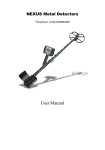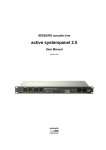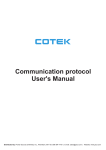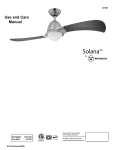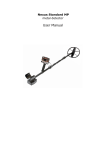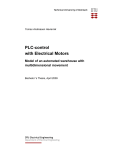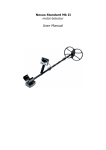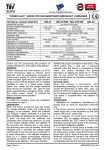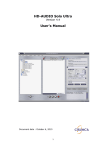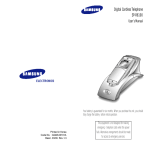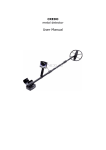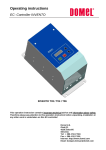Download User Manual - Nexus Metal Detectors
Transcript
NEXUS Metal Detectors Telephone +44(0)7909895085 User Manual GENERAL DESCRIPTION The Nexus Coronado is an Analogue Induction Balance (IB) metal detector that operates in the audio frequency range and it is designed for use on Inland Sites. The Nexus Coronado can also be used in salt-water contaminated conditions, such as tidal beaches. It may be used in either of the few basic modes of operation; All Metal, Discrimination, Voltage Controlled Oscillator (VCO) or VCO plus Discrimination. The Nexus Coronado is designed to be a general-purpose metal detector, capable of finding both small and large targets at extreme depths. The standard coil supplied is the dual 6” Coronado Silver search coil tuned at 8.5 kHz +/-0.5 and it is ideal for general searching operations. There are number of accessory search coils available designed for optimum performance when searching for the tiniest targets in difficult conditions or larger objects and hoards. To obtain the best results with the Nexus Coronado, as with all metal detectors, it is essential to understand the settings and operation of the detector. Considerable experience in metal detecting is not essential when using the Nexus Coronado and it is relatively easy for beginners in the hobby to learn to use it. However all users will need to practice and experiment in order to obtain the best possible results on any particular site. All sites and soils are different and settings that will give good results on one site may be less successful if used elsewhere. The Nexus Coronado is designed to detect very deep targets and operates near to the limits of what is achievable with induction balance. Each Nexus is hand-built so that there may be minor cosmetic differences between individual units. Each coil is tuned to a slightly different frequency within the design range, to minimize interference from other Nexus detectors. Performance values for all Nexus Coronado detectors will be identical when the same search coils are in use. 2 ASSEMBLY AND PREPERATION The Nexus Coronado is supplied ready assembled, with the telescopic stem retracted. To prepare the Nexus for use, simply extend the lower stem section and by using the locking pin underneath fix the two poles in working position. The locking pin is indecated underneath the stem with two small labels, one on the top pole and the other on the lower part. While pulling out the lower part of the stem look for the second label to show. The locking pin will come out in the designated hole when the two labels are in line. Slacken the coil to stem joint bolt slightly and adjust the coil angle to the stem so that, when holding the Nexus Coronado for searching, the coil is parallel to the ground surface. Tighten the coil bolt by hand. Ensure that the coil cable is not strained at the joint between stem and coil. Check that the coil connector plug is fully inserted into the socket on the back of the control box. The Nexus Coronado is supplied with 8 AA dry cell alkaline batteries. Remove the four cross-head screws from the base panel of the battery box (the battery box is below the arm cup at the top of the detector stem). Lift off the cover. Insert the batteries, in their correct alignments, into the plastic holder and make sure that all of the terminals have a good electrical contact. Locate the battery holder into the compartment, ensuring the connecting cable is not strained or pinched. Replace the cover and four screws. Do not over-tighten the screws. Connect the headphones to the 6mm jack socket on the battery box. The Nexus Coronado have an internal loudspeaker located in the control box so headphones are not essential, but using them will ensure better results during search. For any headphones that have a volume control, ensure that this is set to MAXIMUM and use the Nexus Coronado Volume knob to set the volume level. 3 CONTROLS The Nexus Coronado has five primary rotary control knobs (six rotary control knobs for Nexus Coronado SGE), located on the front of the control box and two toggle switch controls (one toggle switch control for Nexus Coronado SGE) located on the back of the control box.. Volume Control with On-Off Switch It is located at the top left side on the front of the Control box and it is combined with the Volume control knob. After turning on the switch the audio signal is quiet. Turning the Volume Control Knob to the greatest digit 10 on the scale will allow stronger audio signals. Threshold This knob is located at the bottom left side on the front of the Control box. It sets the level of the threshold tone. The Nexus Coronado may be operated in silent mode, with no audible background tone or with this tone set to give a slight tone level. In order to readily discern the faintest and smallest of signals, operation with a slight background tone is recommended. Sensitivity This knob is located between the threshold and the Ground Balance knobs on the front of the Control box. It controls the level of sensitivity of the responses. The sensitivity level setting will depend on the soil conditions. On contaminated or highly mineralized sites, it may be necessary to reduce 4 the sensitivity to avoid some false signals. Discrimination This knob is located at the top right side on the front of the Control box. It sets the level of the discrimination. Rotating the Discrimination knob to the Accept position on the scale will result in accepting any kind of Rotating to the Reject position on the scale will result in discriminating almost all metal targets with few exceptions relative to very large size or extreme electrical conductivity. Generally, the discrimination level should be set as low as is possible; to avoid masking the smallest and deepest desired targets. Nexus Coronado can also be used as a BEACH DETECTOR. This function is very easy to set by only adjusting the Discrimination level slightly higher to the Reject side untill the salt water signals turn into clicking sounds. In the same time the Mode Toggle Switch has to be pushed in the forward position which is the Discrimination Mode described bellow. Ground balance This knob is used to set the balance of the Nexus Coronado to suit the soil conditions on any given site. Mode Toggle Switch Located under the control box and accessible from the hand-grip, this toggle switch is used to change modes. When pushed forward, the Nexus Coronado operates in Discrimination Mode. In the centre position, the Nexus Coronado operates in All-Metal Mode. The final position is for Discrimination Mode again and is spring-loaded held towards the user to give temporary access to the Discrimination Mode. On releasing this last position, the switch will automatically revert to the centered position, All-Metal Mode setting. Voltage Controlled Oscillator (VCO) toggle switch. The VCO control toggle switch is located on the back of the Control Box above the Mode Toggle Switch. When turned on the VCO will produce high pitch sound for the Nonferrous targets and low pitch sound for the Ferrous targets. The use of VCO allows better discrimination analyze and better pin pointing of the detected targets. Voltage Controlled Oscilator (VCO) rotary control knob For Nexus Coronado SGE only. It is a control potentiometer combined with on / off switch, which unlocks (on) when turned from position 0 to greater number on the scale and locks (off ) when it is turned back to position 0 on the scale. Turning the VCO knob to higher numbers on the scale will define higher pitch for the signals from non ferrous targets. 5 OPERATION No metal detector, however powerful, will operate at its best unless it is set up properly for the conditions in which it is to be used. To obtain the best results and maximum depth and sensitivity to desired targets, the Nexus Coronado must be properly tuned to the site. Having assembled the Nexus Coronado, inserted batteries and connected the headphones (or just use the speaker), the detector is ready for use. Firstly ensure that no metal is in close proximity to the search coil. It is also advisable to carry out the tuning and setting up of the Nexus Coronado away from other detectors or potential sources of electronic interference. Turn the On-Off switch on Volume Control to turn the Nexus Coronado on. A tone will be heard, which will fade in a short period of time. Holding the Nexus with the coil well above ground level, adjust the Sensitivity control knob to minimum. Adjust the Threshold knob to obtain a minimal tone setting. Adjust the Volume knob to set a comfortable level. Adjust the Ground Balance knob on position 5 on the scale. Lower the coil to the ground and sweep slowly to ensure that there are no metal targets in the place you are tuning the Nexus Coronado. When you are satisfied that no metal is in the ground where you are standing, the procedure for Ground Balance tuning can be started. Ground Balance. This is the most important tuning procedure of all. If the Ground Balance is incorrect the detector will pick up false signals. Having all of the mentioned above preparations done begin rising and lowering the search coil in the area 2” to 10”. If a audio signal appear when lifting the coil turn the Ground Balance knob to the higher numbers on the scale ( clock wise). If the audio signal appear when lowering the coil to the ground surface, then turn the Ground Balance knob to the lower numbers on the scale (anti clock wise). Continue to repeat this procedure until the audio signals from the ground minerals disappear or a minimum signal, which could remain is equal in both ways, when raising and lowering the search coil. After the Ground Balance procedure is complete the Nexus Coronado is ready for use. During search position the coil above and parallel to the ground surface as sugested below:: 9" coil: 2" minimum above the ground surface 6” coil: 1,5” minimum above ground surface 6 4” coil: 1” minimum above ground surface Make sure that the coil is swung evenly over and parallel to the ground surface and that the coil does not rise at each end of the swing. Cover the ground in smooth, parallel swings to ensure maximum ground coverage. In All-Metal Mode both ferrous and non-ferrous targets will give the same audio response by a sudden increase in the intensity of the threshold tone. A strong response indicates a large or relatively shallow target and a weak response indicates a small or deep target. Any audio signal in All-Metal Mode may be analyzed by using the VCO. To analyze a signal with the VCO, sweep the coil slowly across the target and listen the audio signal response. The pitch of the sound will change to higher for all Non-ferrous targets and it will lower when iron is detected. The pitch and intensity of the signal responses will change in VCO mode with the changes of the distance between the detected targets and the search coil. In Discrimination Mode good non-ferrous targets will give a clear, welldefined, two-way, repeatable audio signal. Ferrous targets will give a ‘clicking’ audio response or an indistinct and erratic response. Pinpointing is carried by simply X-ing the coil across the signal. The position where the signals are strongest indicates where the target is buried. As with all detectors, when targets are of complex shape or are located at an angle in the soil, pin-pointing may not be entirely accurate. The use of VCO in most cases should help to improve the pinpointing results. TIPS The Nexus Coronado may seem very different in operation to some detectors presently available. Considerable practice and experimentation with the settings is necessary to get the best results on different sites. Users should persist and regular use over a period of weeks is likely to be needed to become proficient, especially in detecting the very deepest and smallest of targets. Sweeping the coil too fast over the ground will result in signals being missed. It must always be remembered that no detector can find what is not there – nor can any detector give a signal unless the coil is passed directly over that target. 7 If you are on a productive site and know how to properly adjust the detector using the Nexus Coronado will guarantee good finds! There will always be sites on which any single detector does not work to peak efficiency. All detectors and sites are different and a particular combination of frequency and filtering might be best on a specific site. Site conditions will significantly affect depths and performance. Heavily furrowed or broken ground or thick stubble are especially difficult. Sites where the ground conditions vary to a considerable degree may require the Ground Balance to be adjusted for best results. CARE All Nexus metal detectors are precision instruments and require careful handling to ensure they remain in good working order. Avoid dropping, impacts or violent shaking of the detector and protect it while transporting. The detector should not be used in extremely wet weather conditions, such as heavy rain, without protecting the control box and the battery box. The coil assembly is fully waterproofed. If water penetrates any of the boxes, switch off the detector and remove the batteries. It is suggested that the detector be placed in a warm place to dry out slowly. Mud and soil should be carefully removed, using a damp cloth or water only. Do not use detergents or abrasives and avoid getting water in the control boxes. When storing the detector for long periods or when shipping, the batteries should be removed. Avoid storing the detector in areas where it will be exposed to extreme temperatures, dust, moisture or contaminants. Do not attempt to modify or repair the detector or allow any unauthorised repair centre to do so. GUARANTEE The Nexus Coronado metal detector is covered for a period of 24 months from date of purchase against all manufacturing defects or loss of 8 performance. The Control Box is sealed and contains no user-serviceable parts. Opening the Control Box will invalidate the Guarantee. This Guarantee does not cover: Damage due to dropping, impact or accident. Damage due to improper use or care of the detector. Damage resulting from leakage of batteries Damage to the coil or coil cable. In the event of any problem, please contact us. Any detector returned under Guarantee must be properly packed and be sent by insured carrier. The sender is responsible for any loss or damage in transit. A full repair and replacement parts service is available. 9









